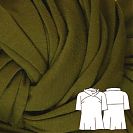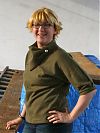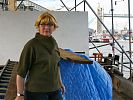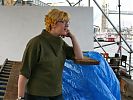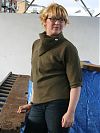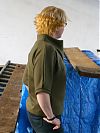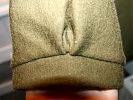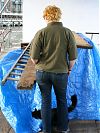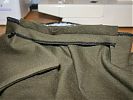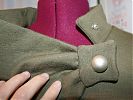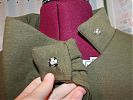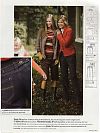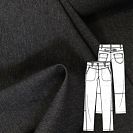Ahhh I finally get my designer fix! Patrones may have stopped attributing designer names to their patterns, but it hasn’t stopped me from adding my own glamour to the mix… This short sleeved top with an interesting gathered and buttoned triangular collar is no1 from the latest issue of Patrones magazine, #285:
So where does the Prada come in? Well, the fabric is a gorgeous ex-Prada olive wool interlock from Ditto Fabrics in Brighton. I’ve only ever sewn wool jersey once before, and after the struggle I had to keep that from rolling onto itself in both directions, plus having to use double layers to keep it from being see-though, I wasn’t overly keen to sew with it again.
But oh my god, the difference between these two fabrics is like night and day! This wool interlock is just beautiful – it washed up a dream, behaves beautifully in the overlocker and sewing machine, presses and molds the way you want it to, and is just SO soft you’d never guess it was wool at all. Honestly, this stuff is just amazing to touch.
If you remember, I had some difficulty visualising how the pattern pieces fit together in this top, partially down to my not speaking Spanish, but also due to the 2D nature of the technical drawings and the one limited magazine photo. So I made a paper model to help figure out that the collar actually is detached from the neckline in front (the neckline being bound by a bias strip) and the sleeves have pleats on the upper arm where they meet the sleeve band. If you’re interested in the construction of this pattern, I recommend you open the earlier post in another tab now to refer back to while you look at the perty photos!
Here you can see that sleeve pleat:
And the back view, with the horizontal seam:
Here’s some closeups of how the collar looks when it’s open:
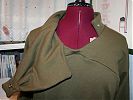
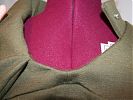
You can see that where the collar detaches from the neckline, there’s still a smooth finish to the neck edge even though it’s always concealed under the collar during normal wear. To achieve this, I overlocked one long edge of the bias strip (which I made to be 4×15cm, but Patrones don’t give dimensions for, btw), then stitched down the other edge alone the neck edge, making sure to overlap the bias strip onto each end of the collar to get a seamless look:
I then pressed this to the inside, understitched the bias strip to the seam allowance, and hand tacked the bias strip to the seam allowances of the upper front piece (Though it’s supposed to be cut with that tiny centre front isthmus on the fold! The seam allowances really came in handy here and the seam is always concealed by the collar so I’d actually recommend doing it my way if you’re playing along at home).
At this point I should also stress how important preserving the shape of the neck edge is to this pattern. There’s a lot of notches and pieces that absolutely must line up, and if anything stretches out, it’s not going to work. So I used Burda’s favourite notion, Vilene bias tape, along the entire neck edge (front and back) but you could also cut your own bias strips of lightweight, woven fusible interfacing or even just staystitch to keep the neck edge true. Also, I used some medium weight woven interfacing on both the back and triangular collar pieces so that they can stand up nicely on their own like in the magazine photo. Think bank robber, not cowl neck!
Another aspect of this pattern that’s not immediately apparent from the tech drawing is that the button on the collar is purely decorative, concealing a snap on the underside that actually does the work. Patrones used a large covered button, but I only had small ones on hand and with the post strike and my not being allowed to use public transport for germy reasons still, getting one in a hurry wasn’t likely to happen. I thought about making my own with a regular button and a bit of fiberfil, but in the end I really liked the look of this silver dome button that’s been in my stash since my velvet jacket so I went with that instead.
If you zoom in on the photo on the right above, you can see two rows of tiny stitches on the inside of the square button piece. I ended up doing these to attach the back of the square to the pleats contained inside to further stabilise the collar piece. Squinting at the magazine photo, it looks like this square piece might’ve been topstitched in their version, but in reality there is just way too much fabric there to get nice stitches (I just got thread snarls underneath that required unpicking, argh!). So in the end I had to do some invisible hand stitching around the edge of the square to attach it to the pleats of the triangular piece, and I wasn’t sure if this would have enough strength if it got pulled in any way.
Reading through these last two posts, this top may look a bit intimidating, but this wasn’t my intention at all! On the contrary, I know quite a few people were planning on sewing this top, too, so I wanted to share all the things I learned during my journey with it so that the rest of you end up with a top you love as much as I do mine!
PS: This is my blonde wig, the one James doesn’t recognise me in sometimes! Only one left to go, which I’ll be wearing with my next project, these KnipMode jeans:


